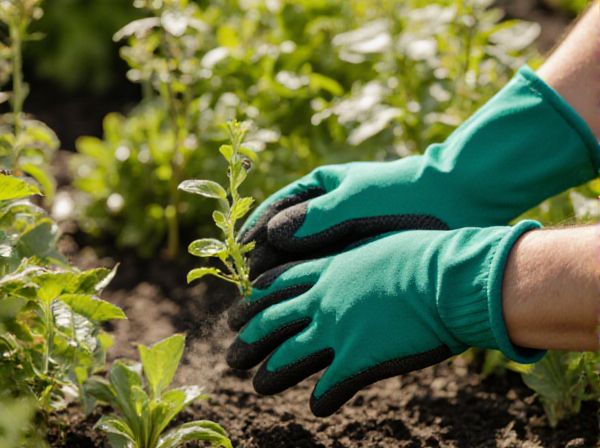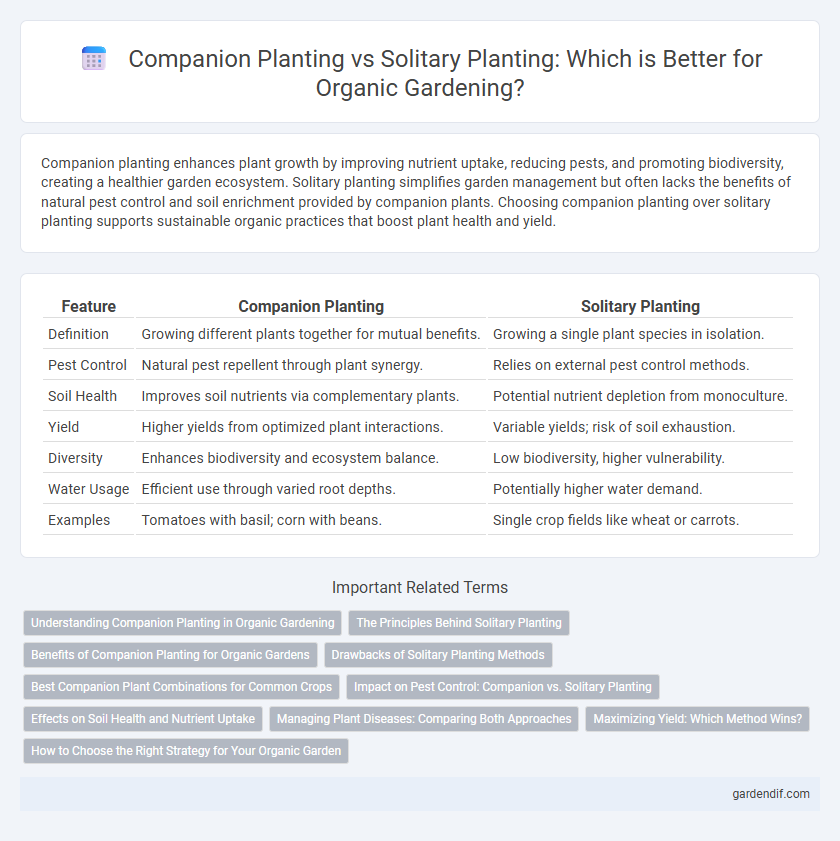
Companion Planting vs Solitary Planting Illustration
Companion planting enhances plant growth by improving nutrient uptake, reducing pests, and promoting biodiversity, creating a healthier garden ecosystem. Solitary planting simplifies garden management but often lacks the benefits of natural pest control and soil enrichment provided by companion plants. Choosing companion planting over solitary planting supports sustainable organic practices that boost plant health and yield.
Table of Comparison
| Feature | Companion Planting | Solitary Planting |
|---|---|---|
| Definition | Growing different plants together for mutual benefits. | Growing a single plant species in isolation. |
| Pest Control | Natural pest repellent through plant synergy. | Relies on external pest control methods. |
| Soil Health | Improves soil nutrients via complementary plants. | Potential nutrient depletion from monoculture. |
| Yield | Higher yields from optimized plant interactions. | Variable yields; risk of soil exhaustion. |
| Diversity | Enhances biodiversity and ecosystem balance. | Low biodiversity, higher vulnerability. |
| Water Usage | Efficient use through varied root depths. | Potentially higher water demand. |
| Examples | Tomatoes with basil; corn with beans. | Single crop fields like wheat or carrots. |
Understanding Companion Planting in Organic Gardening
Companion planting in organic gardening enhances plant health and productivity by strategically pairing species that support each other's growth, such as nitrogen-fixing legumes with nutrient-demanding vegetables. This method reduces the need for synthetic fertilizers and pesticides by promoting natural pest control and improving soil fertility through biodiversity. Understanding these interactions leads to sustainable garden ecosystems that increase yield while maintaining ecological balance.
The Principles Behind Solitary Planting
Solitary planting centers on providing individual plants with ample space, nutrients, and light to maximize their growth potential and reduce competition. This practice minimizes the risk of disease spread and pest infestations by isolating each plant, creating a controlled environment for optimal development. The principle relies heavily on understanding species-specific needs for soil, water, and sunlight without interference from neighboring plants.
Benefits of Companion Planting for Organic Gardens
Companion planting enhances organic gardens by improving pest control through natural repellents and attracting beneficial insects, reducing the need for chemical pesticides. It also promotes healthier soil by facilitating nutrient exchange between complementary plants, boosting overall plant growth and yield. This sustainable practice supports biodiversity and fosters a resilient garden ecosystem, leading to more productive and environmentally friendly organic gardening.
Drawbacks of Solitary Planting Methods
Solitary planting methods often lead to increased vulnerability to pests and diseases due to lack of biodiversity, resulting in higher dependency on chemical treatments. This approach can cause soil nutrient depletion as plants do not benefit from complementary nutrient cycles present in companion planting. Moreover, solitary planting reduces overall garden resilience, limiting natural pest control and soil enhancement benefits provided by diverse plant interactions.
Best Companion Plant Combinations for Common Crops
Tomatoes thrive when paired with basil and carrots, which enhance growth and deter pests through natural synergy. Beans improve soil nitrogen levels, benefiting corn planted nearby by boosting nutrient availability and supporting robust stalk development. Marigolds planted alongside cucumbers repel harmful nematodes, promoting healthier plants and higher yields in organic gardens.
Impact on Pest Control: Companion vs. Solitary Planting
Companion planting enhances natural pest control by attracting beneficial insects and repelling harmful pests through plant diversity, creating a balanced ecosystem that reduces the need for chemical pesticides. Solitary planting often lacks this biodiversity, making crops more vulnerable to pest infestations and increasing dependency on synthetic pest control methods. Studies show companion planting can lower pest populations by up to 60%, promoting healthier organic garden environments.
Effects on Soil Health and Nutrient Uptake
Companion planting enhances soil health by promoting diverse microbial activity and improving nutrient cycling through complementary root systems. Solitary planting often leads to nutrient depletion due to uniform root structures competing for the same resources. Increased biodiversity in companion planting supports better nutrient uptake efficiency and sustainable soil fertility.
Managing Plant Diseases: Comparing Both Approaches
Companion planting enhances disease management by reducing pest populations and promoting beneficial insect habitats, thereby minimizing the spread of pathogens. Solitary planting may simplify monitoring but often lacks the natural disease suppression found in mixed plantings, leading to higher susceptibility. Integrating disease-resistant varieties within companion planting systems further strengthens plant health and reduces reliance on chemical treatments.
Maximizing Yield: Which Method Wins?
Companion planting enhances crop yield by leveraging symbiotic relationships where plants like beans fix nitrogen for corn, improving soil fertility and reducing pest infestations naturally. Solitary planting simplifies management but often requires more synthetic inputs to maintain soil health and control pests, potentially limiting overall productivity. Studies show organic gardens practicing companion planting report up to 20-30% higher yields compared to solitary planting due to optimized nutrient use and pest resistance.
How to Choose the Right Strategy for Your Organic Garden
Selecting the appropriate planting strategy for an organic garden depends on crop compatibility, pest control needs, and soil health goals. Companion planting enhances biodiversity, encourages beneficial insect populations, and improves nutrient uptake, making it ideal for diverse garden layouts and pest-prone environments. Solitary planting suits crops requiring specific nutrient levels or space management, ensuring focused resource allocation and minimizing competition.
Companion Planting vs Solitary Planting Infographic

 gardendif.com
gardendif.com